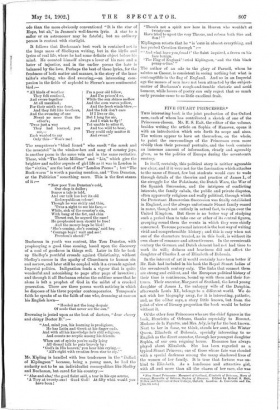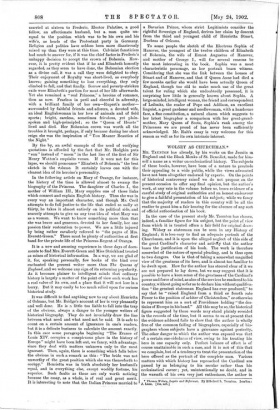FIVE STUART PRINCESSES.*
THIS interesting book is the joint production of five Oxford men, each of whom has contributed a sketch of one of the Princesses chosen. Mr. R. S. Rait, the editor of the volume, besides writing the article on Sophia of Hanover, opens it with an introduction which sets forth its scope and aims. The writers appear to have set themselves, on the whole, to paint the surroundings of the Princesses even more vividly than their personal portraits, and the book contains an immense amount of information, clearly and agreeably given, as to the politics of Europe during the seventeenth century.
In itself, certainly, this political story is neither agreeable nor clear, and if it were not for the fascination which attaches to the name of Stuart, few but students would care to wade through details of the theories and practice of James L, of the struggle for the Palatinate, the Dutch Wars, the War of the Spanish Succession, and the intrigues of conflicting interests, the family cabals, the public and private disputes, often apparently religious and really political, through which the Protestant Hanoverian Succession was finally established in England, and the always unfortunate Stuart family ceased in name, though not entirely in actual fact, to reign over the United Kingdom. But there is no better way of studying such a period than to take one or other of its central figures, grouping round them the events in which they were chiefly concerned. To rouse personal interest is the best way of writing vivid and comprehensible history; and this is eau when not one of the characters treated, as in this book, is without its own share of romance and attractiveness. In the seventeenth century the German and Dutch element had not had time to work its will ; dulness and heaviness did not affect the daughter of Charles I. or of Elizabeth of Bohemia.
In the interest of art it would certainly have been better if Mr. Rait had included in his book the Royal Stuart ladies of the seventeenth century only. The links that connect them are strong and evident, and the European political history of their time is continuous, bound up with them and their for- tunes. Their ancestor, Margaret of Scotland, the loved young daughter of James I., the unhappy wife of the Dauphin, afterwards Louis XI., belongs to a different world. We do not wish her biography away, for it is interesting, pathetic, and, as the editor says, a story little known, but from the point of view of literary proportion the book would be better without it.
Of the other four Princesses who are the chief figures in the Look, Henrietta of Orleans, thanks especially to Bossuet, Madame de La Fayette, and Mrs. Ady, is by far the best known. Next to her in fame, we think, stands her aunt, the Winter Queen, Elizabeth of Bohemia, specially interesting to us English as the direct ancestor, through her youngest daughter Sophia, of our own reigning house. Romance has always played about Elizabeth. She has been regarded as a typical Stuart Princess ; one of those whose fate was clouded with a special darkness among the many shadowed lives of the women of her family. It is true that fortune was un- kind to Elizabeth. As a handsome and attractive girl, with all and more than all the charm of her race, she was
• Firs Stuart Princes,,,: Margaret of Scotland, Elisabeth of Bohentsa, Mary of Orange, Henrietta of Orleans, Sophia of Hanover. Edited by Robert S. Bait, Fcliow and Lecturer of New College, Oxford. London: A. Constable and Co. [12s. Gd. net.]
married at sixteen to Frederic, Elector Palatine, a good fellow, an affectionate husband, but a. man quite un- equal to the position which was to be his own and his wife's, as heads of the Protestant party in Germany. Religion and politics have seldom been more disastrously mixed up than they were at this time. Calvinist fanaticism had much to answer for, if it was the chief factor in Frederic's unhappy decision to accept the crown of Bohemia. How- ever, it is pretty evident that if he and Elizabeth honestly regarded, as they seem to have done, the Bohemian election as a divine call, it was a call they were delighted to obey. Their enjoyment of Royalty was short-lived, as everybody knows ; gaining something to lose everything, they only climbed to fall, and that finally. Sorrow and poverty-stricken exile were Elizabeth's portion for most of her life afterwards. Yet she remained a "real Princess," a heroine of romance, then as now. Fearless in peril and cheerful in adversity, with a brilliant family of her own—Rupert's mother— surrounded by faithful friends and adorers, a devoted wife, an ideal Englishwoman in her love of animals and of field sports ; bright, careless, sometimes frivolous, yet plain- spoken and high-principled ; so the "Queen of Hearts" lived and died. Her Bohemian crown was worth all the troubles it brought, perhaps, if only because during her short reign she was the inspiration of "You Meaner Beauties of the Night."
By the by, an awful example of the need of verifying quotations is afforded by the fact that Mr. Hodgkin puts "sun" instead of " moon " in the last line of the first of Sir Henry Wotton's exquisite verses. If it were not for this lapse, we should pronounce "Elizabeth of Bohemia" the best sketch in the vulume. It certainly leaves one with the clearest idea of its heroine's personality.
In the following article on Mary of Orange, for instance, the history of the time is allowed almost to swamp the biography of the Princess. The daughter of Charles I., the mother of William III., Mary supplies one of those links which connect and explain English history. Thus she was in every way an important character, and though Mr. Cecil attempts to do full justice to the life that ended so sadly at thirty, he takes it almost entirely on its political side, and scarcely attempts to give us any true idea of what Mary was as a woman. We want to know something more than that she was brave and generous, devoted to her family, her one passion their restoration to power. We are a little injured by being rather cavalierly referred to "the pages of Mrs. Everett-Green." There must be plenty of authorities at first hand for the private life of the Princess-Regent of Orange.
It is a new and amusing experience in these days of docu- ments to find Mrs. Everett-Green and Miss Strickland treated as mines of historical information. In a way, we are glad of it, for, speaking personally, few books of the kind ever enchanted the present writer more than The Queens of England, and we welcome any sign of its returning popularity. As it becomes plainer to intelligent minds that ordinary history is largely a matter of the point of view such work has a real value of its own, and a place that it will not lose in a hurry. But it may easily be too much relied upon for serious historical study.
It was difficult to find anything new to say about Henrietta of Orleans, but Mr. Bridge's account of her is very pleasantly and well done. He is a little too liable to fall into the trap of the obvious, always a danger to the younger writers of historical biography. They do not invariably draw the lino between what need and what need not be said. It is safe to count on a certain amount of ignorance in one's readers, but it is a delicate business to calculate the amount exactly. In this case some paragraphs beginning "The France of Louis XIV. occupies a conspicuous place in the history of Europe" might have been left out, we fancy, with advantage, since they deal with matters unknown only to the most ignorant. Then, again, there is something which falls below the obvious in such a remark as this : "The bride was not unworthy of the great position which she was thenceforth to occupy." Henrietta was in birth absolutely her husband's equal, and in everything else, except worldly fortune, his superior. Such faults as these are only worth noticing because the essay, as a whole, is of real and great merit. It is interesting to note that the Italian Princess married to
a Bavarian Prince, whom strict Legitimists consider the rightful Sovereign of England, derives her claim by descent from the third and youngest child of Henrietta Stuart, Duchess of Orleans.
To some people the sketch of the Electress Sophia of Hanover, the youngest of the twelve children of Elizabeth of Bohemia, the wife of Ernest Augustus of Hanover, and mother of George I., will for several reasons be the most interesting in the book. Sophia was a most characteristic personage, as her portrait bears witness. Considering that she was the link between the houses of Stuart and of Hanover, and that if Queen Anne bad died a few months earlier she would have been actually Queen of England, though too old to make much use of the great talent for ruling which she undoubtedly possessed, it is surprising how little is generally known about Sophia. A large-minded, intelligent woman, the friend and correspondent of Leibnitz, the reader of Pope and Addison, an excellent linguist, a great gardener and needlewoman, with a handsome face, a fine constitution, a natural charm which suggests to her latest biographer a comparison with her great-grand- mother, Mary Queen of Scots, Sophia's rank among the Princesses we are proud of has never been sufficiently acknowledged. Mr. Rait's essay is very welcome for this reason as well as for its own intrinsic interest.







































 Previous page
Previous page